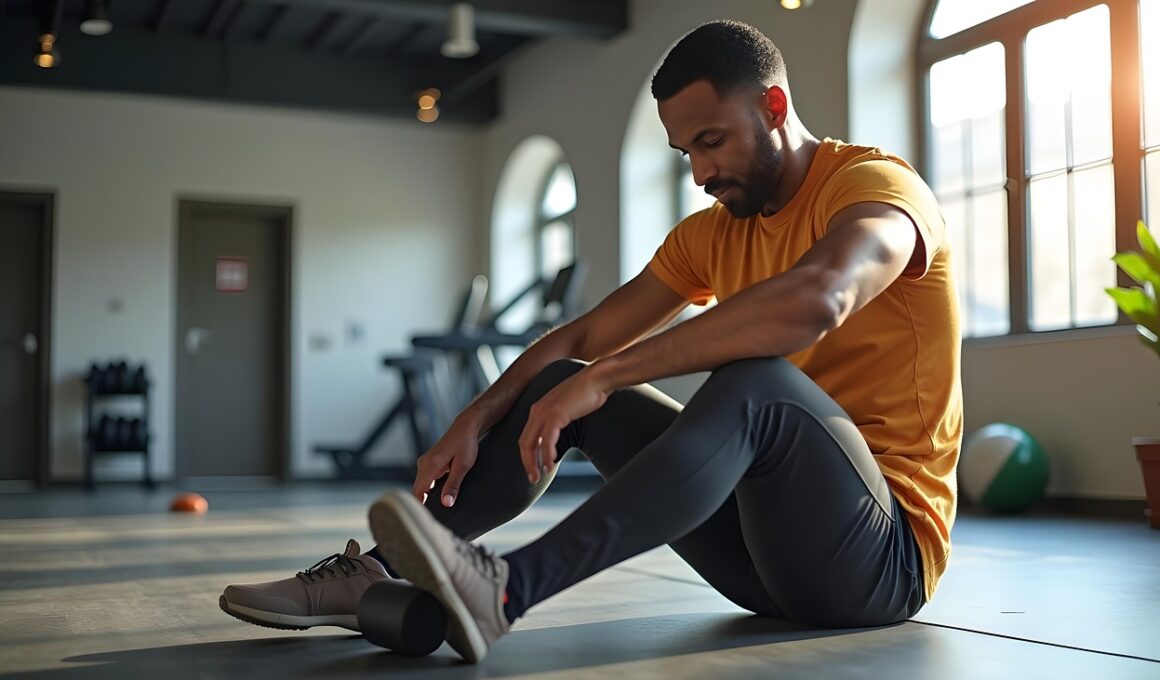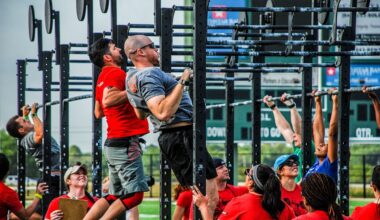Using Foam Rolling to Complement Flexibility Training
Flexibility training plays a critical role in enhancing performance and preventing injuries for athletes. One effective method to improve flexibility is foam rolling, which aids in muscle recovery and promotes optimal mobility. Foam rolling, also known as self-myofascial release, alleviates tension in muscles and fascia, making it an ideal complement to traditional stretching techniques. By increasing blood flow and reducing soreness, foam rolling can enhance the benefits of static and dynamic stretches performed in flexibility training. This technique is particularly beneficial for athletes engaging in high-intensity sports, where muscle tightness is common. Moreover, it is easy to incorporate, requiring minimal equipment and time. Athletes often utilize foam rollers on major muscle groups, such as the quadriceps, hamstrings, and calves, thus actively targeting areas requiring attention. The gentle pressure exerted during foam rolling helps to break down scar tissue, and promotes a better range of motion. Integrating foam rolling into a regular training routine can significantly maximize flexibility gains while ensuring efficient recovery from rigorous workouts. In this article, we explore foam rolling’s impact and technique for optimal athletic performance.
The Benefits of Foam Rolling
Incorporating foam rolling into flexibility training offers numerous benefits for athletes. Primarily, foam rolling aids in releasing muscle knots, significantly enhancing muscle elasticity. By improving circulation, foam rolling helps deliver necessary nutrients while removing waste products, essential for muscle recovery. Furthermore, the practice can reduce muscle soreness after intense physical activity, allowing athletes to train effectively without the hindrance of pain. This injury-prevention aspect is especially important for athletes, as injuries can lead to prolonged absences from training and competition. Foam rolling also promotes relaxation and reduces stress, which is crucial for mental focus. A relaxed athlete is more likely to perform at their peak due to improved concentration and reduced anxiety. Additionally, foam rolling can help athletes identify tight spots that may need further attention or specialized treatment. This self-care practice encourages athletes to take charge of their recovery through a manageable routine. Coaches and trainers increasingly recognize the significance of foam rolling; its incorporation into warm-up and cool-down routines effectively contributes to overall athletic performance. Thus, foam rolling can be an invaluable tool in any athlete’s training regimen.
Foam rolling can be particularly effective when performed before and after workouts. During pre-workout routines, it helps activate muscles and prepares them for the physical demands ahead. The gentle pressure placed on the muscles wakes them up, enhancing their readiness for activity. This pre-workout session should focus on major muscle groups used in a specific sport, ensuring that the athlete is physically prepared. Conversely, post-workout foam rolling can aid in recovery by reducing muscle tightness accumulated throughout the training session. This restorative element allows athletes to recover faster and remain consistent in their training efforts. To maximize results, athletes should aim for five to ten minutes of foam rolling before and after workouts, focusing on high-impact areas. Adequate time spent rolling can yield significant improvements in flexibility gains while minimizing muscle soreness. Many athletes have adopted foam rolling as a part of their daily routine, further emphasizing its effectiveness in promoting flexibility. Coaches and trainers often monitor foam rolling sessions to adjust practices according to individual needs. By integrating this simple technique into training schedules, athletes can reap the benefits of increased overall flexibility and mobility.
Choosing the Right Foam Roller
When selecting a foam roller, athletes must consider the density and size suitable for their individual needs. Foam rollers vary in firmness, with softer options recommended for beginners, while firmer rollers provide deeper pressure for advanced users. The ideal foam roller should be firm enough to provide effective muscle relief without causing significant discomfort. Many athletes choose to invest in textured rollers, which feature bumps or ridges to target specific muscle groups more effectively. However, these may not be suitable for everyone; sensitivity varies among individuals. Roller size also plays an important role in accessibility; while shorter rollers are easier to store and transport, longer rollers enable athletes to cover broader areas with ease. Athletes are encouraged to test different types and find one that aligns with their comfort level and personal preference. When used properly, foam rollers can dramatically improve flexibility training results. Proper care and maintenance also enhance the longevity of foam rollers; regular cleaning is essential. Keeping the foam roller in good condition not only aids performance but also ensures hygienic usage. Thus, choosing the right foam roller can significantly impact an athlete’s training efficacy and recovery outcomes.
To achieve optimal flexibility benefits, it is essential to pair foam rolling with appropriate stretching techniques. Combining these two practices creates a synergistic effect, resulting in enhanced muscle lengthening and recovery. Athletes should focus on dynamic stretches after foam rolling, which helps maintain muscle warmth and prepares them for intensive movement patterns. These dynamic stretches should be sport-specific, catering to the movements involved in an athlete’s discipline. Some popular dynamic stretches include leg swings, lunge walks, and arm circles. Static stretches are best performed after workouts, allowing muscles to relax and lengthen effectively. The key is to listen to your body and ensure both methods contribute to an overall flexibility plan. Over time, regular foam rolling and stretching should result in noticeable gains in flexibility. A consistent approach to training and recovery leads to enhanced performance, increased range of motion, and an overall sense of well-being. Athletes who adopt this holistic strategy can effectively optimize their athletic capabilities. They may even find themselves competing at higher levels, picking up new techniques more quickly, and experiencing fewer injuries while enjoying sports more fully.
Integrating Foam Rolling into Practice
Integrating foam rolling into an athlete’s regular training routine is crucial for maximizing flexibility and enhancing performance. Coaches should lead the initiative, teaching athletes how to properly incorporate this technique with their existing workouts and recovery plans. A structured foam rolling session should begin with a brief explanation and guidelines covering how to utilize the roller effectively. Establishing a routine improves athletes’ compliance and understanding of the technique’s importance. Incorporating visual demonstrations and peer support can enhance the experience, ultimately making sessions more engaging and informative. As athletes become more comfortable with foam rolling, they will naturally begin to recognize areas requiring attention. Regular reminders of the benefits will help reinforce the relevance of foam rolling. Athletes may also benefit from tracking their flexibility progress over time, noting improvements associated with consistent foam rolling practices. This data can motivate adherence and commitment. Coaches must emphasize that foam rolling is not a substitute for comprehensive flexibility training but serves as a valuable complement. Instead of viewing it as an additional chore, athletes can embrace foam rolling as a vital component of their training regimen.
In conclusion, foam rolling is a powerful tool that can significantly enhance flexibility training for athletes. It provides numerous benefits, such as improved muscle recovery, increased blood flow, reduced soreness, and prevention of injuries. The effectiveness of foam rolling is further amplified when combined with proper stretching techniques. Ultimately, athletes are encouraged to adopt a well-rounded training approach that includes both foam rolling and flexibility exercises. The positive outcomes—enhanced performance and overall well-being—make it well worth the effort. Coaches, trainers, and athletes all play a pivotal role in promoting foam rolling as an essential practice for athletic development. Moving forward, understanding the most effective methods, and personalizing routines will yield the best results. This comprehensive strategy will help athletes achieve their maximum potential, ensuring their continued improvement. As their flexibility increases, they will enjoy improvement in agility, strength, and endurance while reducing fatigue. Flexibility training with foam rolling is a winning combination for any athlete looking to enhance their performance. They will find that engaging consistently in this practice allows them to stay at the top of their game in all athletic endeavors.


